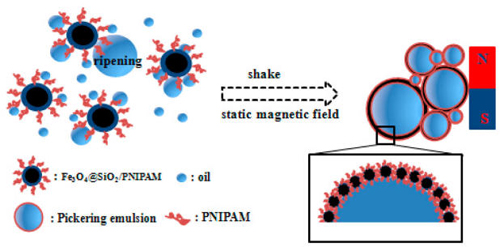With the increasing industrial oily waste water and the frequent oil spill accidents, advanced materials or techniques that can effectively separate oil and water have attracted extensive attention in recent years. The core−shell structured particles show flexible features in oil/water separation. For example, the magnetic nanoparticles with superhydrophobic/ superoleophilic property are reported to achieve oil/water separation and induce droplet transport. However, their separation efficiency is far less than applicable requirements. Furthermore, the superhydrophobic nanoparticles are not suitable for the separation of microemulsion because of their poor dispersion in water. Although the reasonable design can endow those composite particles with attractive features, this above-mentioned method does not reflect the advantage of nanoparticles with high specific surface area.
The research group for polymer self-lubricating composite materials at the Lanzhou Institute of Chemical Physics (LICP) of the Chinese Academy of Sciences (CAS) has synthesized polymer-grafted magnetic composite particles and applied them in harvesting oil by use of their special wettability.
Different from gravity-driven oil−water separation, the prepared polymer brushes-grafted magnetic composite particles can act as solid-stabilizers that diffuse to the oil−water interfical region and effectively minimize the direct oil−water interfical area by volume exclusion, whereas the magnetic Fe3O4 core allows easy separation of Pickering emulsions from oil−water mixture under an external magnetic field. When the emulsions were heated from room temperature to 50 °C, the coil-to-globule transition of poly(N-isopropylacrylamide) (PNIPAM) acts as the driving force for the destabilization of the emulsion, thereby achieving the release of oil.
The study on oil separation from hexane/water mixture, toluene/water mixture, hexadecane/water mixture and chloroform/water mixture show that the transimittance of water after oil separation are all above 95% in the cases of the separation of microemulsion. After 5 cycles, the stimuli-responsive composite particles still maintain high separation efficiency, which demonstrates their good resistance to fouling.
It is hoped that the Pickering emulsion stabilized by stimuli-responsive composite particles will provide a new method for practical application in oil harvesting and microfluidic devices.
The work has received support from the National Science Foundation for Distinguished Young Scholars of China and the National Natural Science Foundation of China. The findings have been published in ACS Appl. Mater. Interfaces(Appl. Mater. Interfaces2014, 6, 13334−13338).

Schematic illustration of the proposed mechanism of the separation of oil-in-water emulsion by PNIPAM-carring magnetoesponsive particles. (Omage by WANG Qihua et al.)

